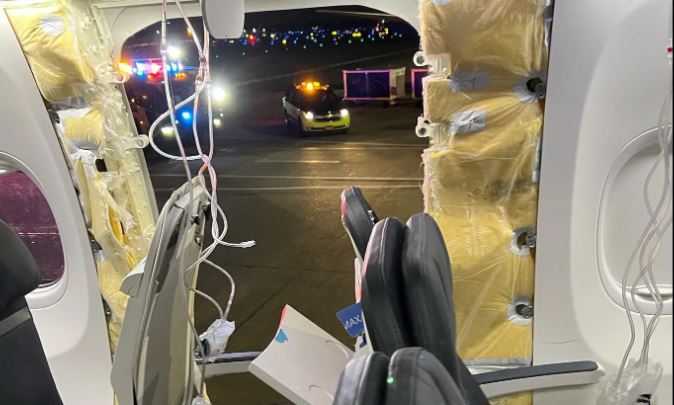
Alaska Airlines: Missing Door ‘Plug’ May Hold Vital Clues
Investigators are currently searching for a section of fuselage that detached from a Boeing airliner flying over Oregon last Friday. This incident has prompted a deeper inquiry into the structural integrity of the aircraft.
The lost fuselage part was a “plug” used by Boeing to seal an unused emergency exit on the Alaska Airlines jet. These plugs are commonly found on Boeing 737 Max 9 jets. As a precaution, the Federal Aviation Administration has grounded these aircraft for inspections.
The need for these plugs arises from the design requirements of larger Boeing 737 models, which include additional emergency exits to ensure passengers can evacuate quickly. Airlines like Lion Air and Corendon Dutch Airlines, which use more than 200 seats in their Max 9s, require these extra exits. However, Alaska Airlines and United Airlines, the only two U.S. operators of the Max 9, have a seating arrangement below 180, eliminating the need for mid-cabin exits. Thus, they use plugs instead.
Boeing’s earlier 737-900 models and the Max 8 also offer the option for additional exits or plugs, depending on the buyer’s preference.
Spirit AeroSystems, a company distinct from Spirit Airlines, is responsible for installing these door plugs on Max 9s, as confirmed by a spokesperson to The New York Times. This process takes place at Spirit’s factory in Wichita, Kansas. Spirit AeroSystems, a major supplier for Boeing’s commercial planes, has faced recent scrutiny for manufacturing quality issues on the Max and the Boeing 787 Dreamliner.
The National Transportation Safety Board (NTSB), led by chair Jennifer Homendy, is investigating the incident. Their investigation, expected to take over a year, will include a metallurgical analysis of the door plug and its components. Experts emphasize the importance of examining the door, as metal often reveals crucial information about structural failures.
There is no indication that exit door plugs are a typical weak point in aircraft fuselages. This incident appears to be unprecedented for Alaska Airlines. The NTSB is also looking into the plane’s maintenance records, even though it’s relatively new, due to previous pressurization issues reported on the same aircraft.
Fuselage blowouts, while rare, have occurred in aviation history, often due to metal fatigue. Notable incidents include the 1988 Aloha Airlines tragedy, where a flight attendant was lost after a large section of the roof came off, and two incidents involving Southwest Boeing 737s in 2009 and 2011, both attributed to metal fatigue but without any injuries.
Investigators are currently searching for a section of fuselage that detached from a Boeing airliner flying over Oregon last Friday. This incident has prompted a deeper inquiry into the structural integrity of the aircraft.
The lost fuselage part was a “plug” used by Boeing to seal an unused emergency exit on the Alaska Airlines jet. These plugs are commonly found on Boeing 737 Max 9 jets. As a precaution, the Federal Aviation Administration has grounded these aircraft for inspections.
The need for these plugs arises from the design requirements of larger Boeing 737 models, which include additional emergency exits to ensure passengers can evacuate quickly. Airlines like Lion Air and Corendon Dutch Airlines, which use more than 200 seats in their Max 9s, require these extra exits. However, Alaska Airlines and United Airlines, the only two U.S. operators of the Max 9, have a seating arrangement below 180, eliminating the need for mid-cabin exits. Thus, they use plugs instead.
Boeing’s earlier 737-900 models and the Max 8 also offer the option for additional exits or plugs, depending on the buyer’s preference.
Spirit AeroSystems, a company distinct from Spirit Airlines, is responsible for installing these door plugs on Max 9s, as confirmed by a spokesperson to The New York Times. This process takes place at Spirit’s factory in Wichita, Kansas. Spirit AeroSystems, a major supplier for Boeing’s commercial planes, has faced recent scrutiny for manufacturing quality issues on the Max and the Boeing 787 Dreamliner.
The National Transportation Safety Board (NTSB), led by chair Jennifer Homendy, is investigating the incident. Their investigation, expected to take over a year, will include a metallurgical analysis of the door plug and its components. Experts emphasize the importance of examining the door, as metal often reveals crucial information about structural failures.
There is no indication that exit door plugs are a typical weak point in aircraft fuselages. This incident appears to be unprecedented for Alaska Airlines. The NTSB is also looking into the plane’s maintenance records, even though it’s relatively new, due to previous pressurization issues reported on the same aircraft.
Fuselage blowouts, while rare, have occurred in aviation history, often due to metal fatigue. Notable incidents include the 1988 Aloha Airlines tragedy, where a flight attendant was lost after a large section of the roof came off, and two incidents involving Southwest Boeing 737s in 2009 and 2011, both attributed to metal fatigue but without any injuries.
Investigators are currently searching for a section of fuselage that detached from a Boeing airliner flying over Oregon last Friday. This incident has prompted a deeper inquiry into the structural integrity of the aircraft.
The lost fuselage part was a “plug” used by Boeing to seal an unused emergency exit on the Alaska Airlines jet. These plugs are commonly found on Boeing 737 Max 9 jets. As a precaution, the Federal Aviation Administration has grounded these aircraft for inspections.
The need for these plugs arises from the design requirements of larger Boeing 737 models, which include additional emergency exits to ensure passengers can evacuate quickly. Airlines like Lion Air and Corendon Dutch Airlines, which use more than 200 seats in their Max 9s, require these extra exits. However, Alaska Airlines and United Airlines, the only two U.S. operators of the Max 9, have a seating arrangement below 180, eliminating the need for mid-cabin exits. Thus, they use plugs instead.
Boeing’s earlier 737-900 models and the Max 8 also offer the option for additional exits or plugs, depending on the buyer’s preference.
Spirit AeroSystems, a company distinct from Spirit Airlines, is responsible for installing these door plugs on Max 9s, as confirmed by a spokesperson to The New York Times. This process takes place at Spirit’s factory in Wichita, Kansas. Spirit AeroSystems, a major supplier for Boeing’s commercial planes, has faced recent scrutiny for manufacturing quality issues on the Max and the Boeing 787 Dreamliner.
The National Transportation Safety Board (NTSB), led by chair Jennifer Homendy, is investigating the incident. Their investigation, expected to take over a year, will include a metallurgical analysis of the door plug and its components. Experts emphasize the importance of examining the door, as metal often reveals crucial information about structural failures.
There is no indication that exit door plugs are a typical weak point in aircraft fuselages. This incident appears to be unprecedented for Alaska Airlines. The NTSB is also looking into the plane’s maintenance records, even though it’s relatively new, due to previous pressurization issues reported on the same aircraft.
Fuselage blowouts, while rare, have occurred in aviation history, often due to metal fatigue. Notable incidents include the 1988 Aloha Airlines tragedy, where a flight attendant was lost after a large section of the roof came off, and two incidents involving Southwest Boeing 737s in 2009 and 2011, both attributed to metal fatigue but without any injuries.








































